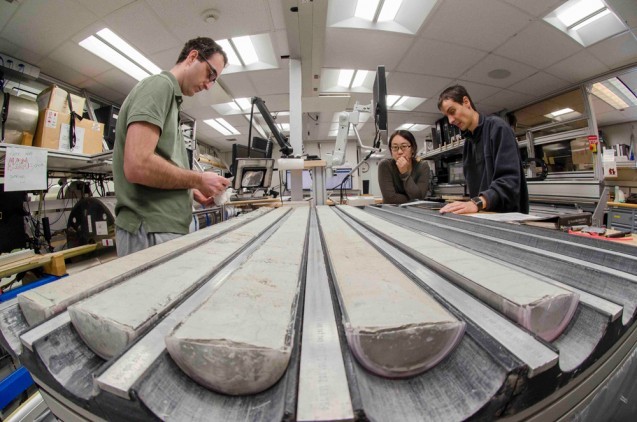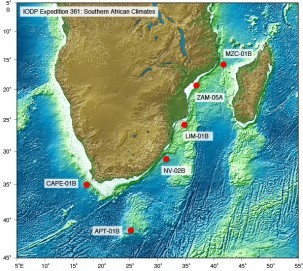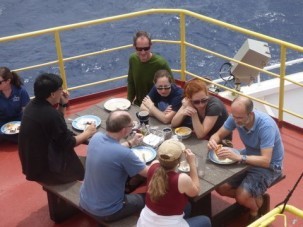We’re Headed for Mozambique!
After weeks of anticipation, permission arrived just in time to core off Mozambique. Sidney Hemming and her team of scientists aboard the JOIDES Resolution are excited about what they might learn from the ocean sediment.

Read Sidney Hemming’s first post to learn more about the goals of her two-month research cruise off southern Africa and its focus on the Agulhas Current and collecting climate records for the past 5 million years.
At the time of the previous entry, we were heading toward the waters off Mozambique while hoping government permission would be in hand in time for coring. It was a month after we had left port in Mauritius, and we had a couple of firm deadlines – well, actually one that we later revised due to the delay because of the helicopter evacuation. We decided that if we did not have approval from Mozambique’s Fisheries office by Wednesday, we would give up hope and head to our CAPE site, off the tip of South Africa, with the prospect of another site that was not part of our original plan as a consolation prize.
We did not hear back on Wednesday, so we stopped and brought extra pipe up for the potential extra site. Thursday morning, with no word from Mozambique, we began to head south. Approximately 24 hours later WE GOT PERMISSION! I cannot tell you what an emotional roller coaster this has been for the entire party. Some of us had already started warming up to the alternative site, but everybody is ecstatic that we finally have verbal permission for the Mozambique sites. We hope cores from the Zambezi and Limpopo sites, near major rivers that run through Mozambique, will give us a record of the terrestrial climate variability in southeastern Africa through the last 5 million years that can be compared with the Agulhas Current and other oceanographic factors.

We are approaching our northernmost site, which is a re-occupation of an old Deep Sea Drill Project (DSDP) site 242 on the Davie Ridge in the northern part of the Mozambique Channel. The site, MZC, which will be IODP 1476, in some ways, is more exploratory than the other five of our expedition although there are hints that this will be a good spot for paleoceanography. The original drilling was done in 1972 during the 25th leg of the DSDP—they sailed from Mauritius, too, on the Glomar Challenger, and ended in Durban, South Africa.
As an aside, this reminds me how the DSDP and its descendants—the Ocean Drilling Program, Integrated Ocean Drilling Program, and the current International Ocean Discovery Program (IODP)—have made an incredible legacy of understanding the evolution of the ocean basins and the evolution of the oceans and climate system through the Cenozoic. We would know far less without these extraordinary programs. The DSDP site 242 was drilled to understand the history of separation between Africa and Madagascar, and to establish a mid-latitude faunal succession (the evolutionary change of marine creatures) for the western Indian Ocean. The hole was drilled and cored intermittently to 676 meters, and the bottom sediment recovered was from the Eocene (~50 million years old). The sediment was nannofossil ooze throughout. Nannofossil ooze is sediment that is made up of mostly calcareous nannofossils, which are single-celled organisms that have a calcium carbonate structure. This is also the composition of the first two sites we cored and a very common composition for tropical and subtropical sites without much terrigenous (land-derived) dust and debris. This location is upstream of the Agulhas Current, and it appears to have an important influence on Natal Pulses (turbulent pulses that are triggered by eddies originating in the Mozambique Channel) that pass down the Natal Valley and lead to the Agulhas Leakage.

We should get to our northernmost site, MCZ/1476, in the early morning on Tuesday March 8. By trimming our program of coring to only include the advanced piston coring and not go to greater depth than needed to capture the 5 million year interval, we think we can still get everything we need at all six sites. It is going to be a really busy final three weeks, but everybody is ready for the challenge.
Meanwhile, the reports are almost finished for site 1475, at the Agulhas Plateau. The correlators were able to put together a splice of cores that provides a continuous section, although there are intervals that will be further scrutinized back home. We had a barbecue on deck Saturday in the nice hot weather, and we are looking forward to the next site.
Sidney Hemming is a geochemist and professor of Earth and Environmental Sciences at Lamont-Doherty Earth Observatory. She uses the records in sediments and sedimentary rocks to document aspects of Earth’s history.
